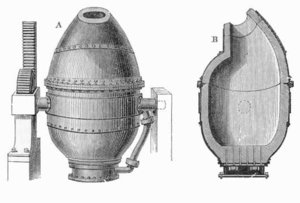Bessemer process
|
|
The Bessemer process was the first inexpensive industrial process for the mass-production of steel from molten pig iron. The process is named after its inventor, Henry Bessemer, who took out a patent on the process in 1855. The process is a development of a practice known in China as early as the 200s. The key principle is removal of impurities from the iron by oxidation through air being blown through the molten iron. The oxidation also raises the temperature of the iron mass and keeps it molten.
The process is carried on in a large ovoid steel container lined with clay or dolomite called the Bessemer converter. The capacity of a converter was from 8 to 30 tons of molten iron with a usual charge being around 15 tons. At the top of the converter is an opening, usually tilted to the side relative to the body of the vessel, through which the iron is introduced and the finished product removed. The bottom is perforated with a number of channels called tuyeres through which air is forced into the converter. The converter is pivoted on trunnions so that it can be rotated to receive the charge, turned upright during conversion, and then rotated again for pouring out the molten steel at the end. The oxidation process removes impurities such as silicon, manganese, and carbon as oxides, these oxides either escape as gas or form a solid slag. The refractory lining of the converter also plays a role in the conversion - the clay lining is used in the acid Bessemer, in which there is low phosphorus in the raw material. Dolomite is used when the phosphorus content is high in the basic Bessemer (limestone or magnesite linings are also sometimes used instead of dolomite). In order to give the steel the desired properties, other substances could be added to the molten steel when conversion was complete, such as spiegeleisen (an iron-carbon-manganese alloy). When the required steel has been formed it is poured out into ladles and then transferred into molds and the lighter slag is left behind. The conversion process (called the "blow") was completed in around twenty minutes. During this period the progress of the oxidation of the impurities is judged by the appearance of the flame issuing from the mouth of the converter; the modern use of photoelectric methods of recording the characteristics of the flame has greatly aided the blower in controlling the final quality of the product. After the blow, the liquid metal is recarburized to the desired point and other alloying materials are added, depending on the desired product.
Before the Bessemer process, steel was manufactured by heating bars of wrought iron together with charcoal for periods of up to a week. The bars were then broken into pieces and melted in small crucibles containing 20kg or so. Up to 3 tons of expensive coke was burnt for each ton of steel produced. Such steel when rolled into bars was sold at £50 to £60 a ton. This process had been supplanted in the 1700s with the introduction of Benjamin Huntsman's crucible steelmaking technique, which reduced the amount of firing time to about three hours, although still requiring massive quantities of coke. The Bessemer process further reduced this time to about 1/2 hour, while requiring only the coke needed to initially melt the iron. The earliest Bessemer converters produced steel for £7 a ton, although they priced it initially at around £40 a ton.
Bessemer_Converter_Sheffield.jpg
Both Bessemer and Huntsman were based in the city of Sheffield, England. Sheffield has an international reputation for steel-making, which dates from 1740, when Benjamin Huntsman discovered the crucible technique for steel manufacture, at his workshop in the district of Handsworth. This process had an enormous impact on the quantity and quality of steel producton and was only made obsolete, a century later, in 1856 by Henry Bessemer's invention of the Bessemer converter which allowed the true mass production of steel. Bessemer had moved his Bessemer Steel Company to Sheffield to be at the heart of the industry. The city's Kelham Island Museum still maintains an early example of a Bessemer converter for public viewing.
The Bessemer process revolutionized the world. Prior to its widespread use steel was far too expensive to use in most applications, and wrought iron was used throughout the Industrial Revolution. After its introduction steel and wrought iron were similarly priced, and all manufacture turned to steel.
In the U.S. commercial steel production using this method stopped in 1968.

